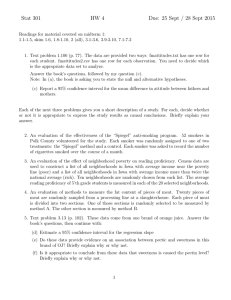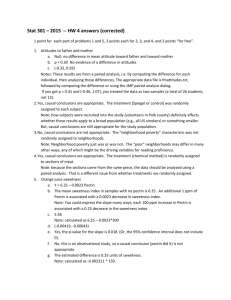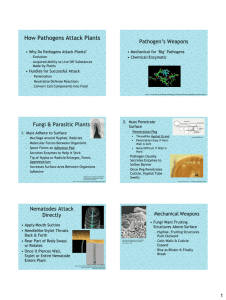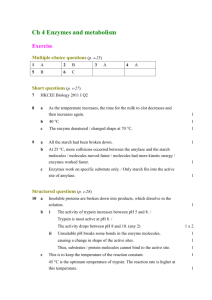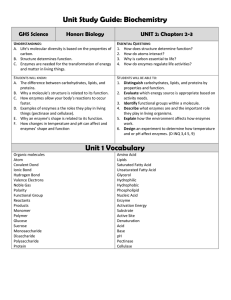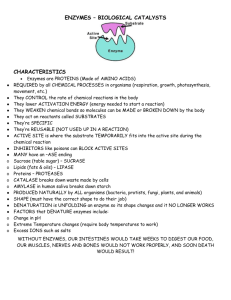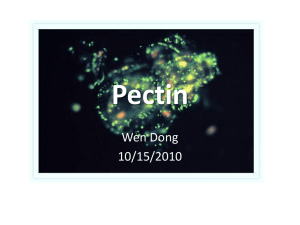Document 13309993
advertisement
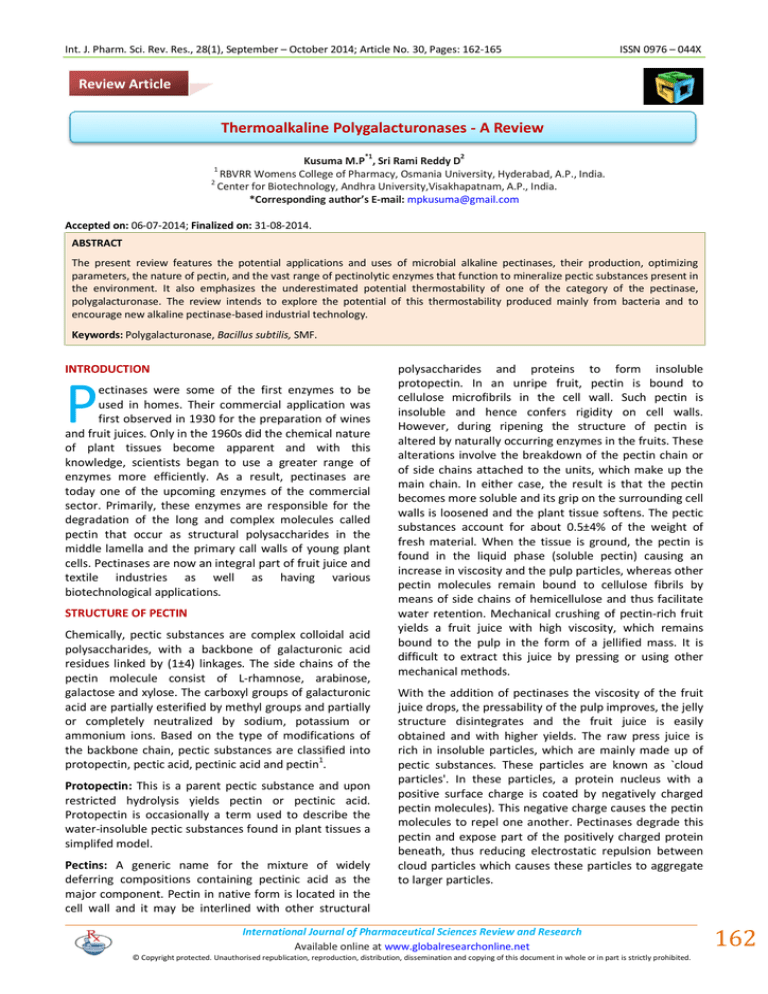
Int. J. Pharm. Sci. Rev. Res., 28(1), September – October 2014; Article No. 30, Pages: 162-165 ISSN 0976 – 044X Review Article Thermoalkaline Polygalacturonases - A Review *1 2 Kusuma M.P , Sri Rami Reddy D RBVRR Womens College of Pharmacy, Osmania University, Hyderabad, A.P., India. 2 Center for Biotechnology, Andhra University,Visakhapatnam, A.P., India. *Corresponding author’s E-mail: mpkusuma@gmail.com 1 Accepted on: 06-07-2014; Finalized on: 31-08-2014. ABSTRACT The present review features the potential applications and uses of microbial alkaline pectinases, their production, optimizing parameters, the nature of pectin, and the vast range of pectinolytic enzymes that function to mineralize pectic substances present in the environment. It also emphasizes the underestimated potential thermostability of one of the category of the pectinase, polygalacturonase. The review intends to explore the potential of this thermostability produced mainly from bacteria and to encourage new alkaline pectinase-based industrial technology. Keywords: Polygalacturonase, Bacillus subtilis, SMF. INTRODUCTION P ectinases were some of the first enzymes to be used in homes. Their commercial application was first observed in 1930 for the preparation of wines and fruit juices. Only in the 1960s did the chemical nature of plant tissues become apparent and with this knowledge, scientists began to use a greater range of enzymes more efficiently. As a result, pectinases are today one of the upcoming enzymes of the commercial sector. Primarily, these enzymes are responsible for the degradation of the long and complex molecules called pectin that occur as structural polysaccharides in the middle lamella and the primary call walls of young plant cells. Pectinases are now an integral part of fruit juice and textile industries as well as having various biotechnological applications. STRUCTURE OF PECTIN Chemically, pectic substances are complex colloidal acid polysaccharides, with a backbone of galacturonic acid residues linked by (1±4) linkages. The side chains of the pectin molecule consist of L-rhamnose, arabinose, galactose and xylose. The carboxyl groups of galacturonic acid are partially esterified by methyl groups and partially or completely neutralized by sodium, potassium or ammonium ions. Based on the type of modifications of the backbone chain, pectic substances are classified into 1 protopectin, pectic acid, pectinic acid and pectin . Protopectin: This is a parent pectic substance and upon restricted hydrolysis yields pectin or pectinic acid. Protopectin is occasionally a term used to describe the water-insoluble pectic substances found in plant tissues a simplifed model. Pectins: A generic name for the mixture of widely deferring compositions containing pectinic acid as the major component. Pectin in native form is located in the cell wall and it may be interlined with other structural polysaccharides and proteins to form insoluble protopectin. In an unripe fruit, pectin is bound to cellulose microfibrils in the cell wall. Such pectin is insoluble and hence confers rigidity on cell walls. However, during ripening the structure of pectin is altered by naturally occurring enzymes in the fruits. These alterations involve the breakdown of the pectin chain or of side chains attached to the units, which make up the main chain. In either case, the result is that the pectin becomes more soluble and its grip on the surrounding cell walls is loosened and the plant tissue softens. The pectic substances account for about 0.5±4% of the weight of fresh material. When the tissue is ground, the pectin is found in the liquid phase (soluble pectin) causing an increase in viscosity and the pulp particles, whereas other pectin molecules remain bound to cellulose fibrils by means of side chains of hemicellulose and thus facilitate water retention. Mechanical crushing of pectin-rich fruit yields a fruit juice with high viscosity, which remains bound to the pulp in the form of a jellified mass. It is difficult to extract this juice by pressing or using other mechanical methods. With the addition of pectinases the viscosity of the fruit juice drops, the pressability of the pulp improves, the jelly structure disintegrates and the fruit juice is easily obtained and with higher yields. The raw press juice is rich in insoluble particles, which are mainly made up of pectic substances. These particles are known as `cloud particles'. In these particles, a protein nucleus with a positive surface charge is coated by negatively charged pectin molecules). This negative charge causes the pectin molecules to repel one another. Pectinases degrade this pectin and expose part of the positively charged protein beneath, thus reducing electrostatic repulsion between cloud particles which causes these particles to aggregate to larger particles. International Journal of Pharmaceutical Sciences Review and Research Available online at www.globalresearchonline.net © Copyright protected. Unauthorised republication, reproduction, distribution, dissemination and copying of this document in whole or in part is strictly prohibited. 162 Int. J. Pharm. Sci. Rev. Res., 28(1), September – October 2014; Article No. 30, Pages: 162-165 CLASSIFICATION OF PECTIC ENZYMES Pectinases are classified under three headings according to the following criteria: whether pectin, pectic acid or oligo-D-galacturonate is the preferred substrate, whether pectinases act by trans-elimination or hydrolysis and whether the cleavage is random (endo-, liquefying of depolymerizing enzymes) or endwise (exo- or saccharifying enzymes). The three major types of pectinases are as follows. Pectinesterases (PE) Pectinesterases also known as pectinmethyl hydrolase, catalyzes deesterifcation of the methoxyl group of pectin forming pectic acid. The enzyme acts preferentially on a methyl ester group of galacturonate unit next to a nonesterifed galacturonate unit. ISSN 0976 – 044X Exo-PMGL: catalyzes stepwise breakdown of pectin by trans-eliminative cleavage. Polygalacturonate lyases (PGL). Catalyze cleavage of a1,4-glycosidic linkage in pectic acid by trans-elimination. They are also of two types: Endo-PGL: also known as poly (1,4-a-D-galacturonide) lyase, catalyzes random cleavage of a-1,4-glycosidic linkages in pectic acid. Exo-PGL: also known as poly(1,4-a-D-galacturonide) exolyase, catalyzes sequential cleavage of a-1,4-glycosidic linkages in pectic acid. Protopectinase This enzyme solubilizes protopectin forming highly polymerized soluble pectin. On the bases of their applications, pectinases are mainly of two types: acidic pectinases and alkaline pectinases. Depolymerizing enzymes These are the enzymes: THERMOSTABLE POLYGALACTURONASES Hydrolyzing glycosidic linkages They include: Polymethylgalacturonases (PMG). Catalyze the hydrolytic cleavage of α -1,4-glycosidic bonds. They may be: Endo-PMG: causes random cleavage of α -1,4glycosidiclinkages of pectin, preferentially highly esterifed pectin. Thermal stability and activity of pectinases are of great significance in biotechnological processes. Regarding bacterial pectinases, the optimal temperature for a PGase from Streptomyces sp. QG-11-3 is 60 °C and the hyperthermophilic bacterium Thermotoga maritima produces an enzyme with optimum activity at 80 °C3. Table 1: Main advantages of high temperature and thermostable enzymes4,5 Exo-PMG: causes sequential cleavage of α -1,4-glycosidic linkage of pectin from the non-reducing end of the pectin chain. Property Thermostability High optimum temperature Polygalacturonases (PG). Catalyze hydrolysis of alpha1,4glycosidic linkages in pectic acid (polygalacturonicacid). They are also of two types: Resistance to denaturing agents Endo-PG: also known as poly (1,4-α-Dgalacturonide)glycanohydrolase, catalyzes random hydrolysis of a-1,4-glycosidic linkages in pectic aci d. Viscosity Exo-PG: also known as poly(1,4α -Dgalacturonide)galacturonohydrolase, catalyzes hydrolysis in a sequential fashion of α -1,4-glycosidic linkages on pectic acid. Cleaving Cleaving a-1,4-glycosidic linkages by trans-elimination, which results in galacturonide with an unsaturated bond between C4 and C5 at the non-reducing end of the galacturonic acid formed. These include: Polymethyl galacturonate lyases (PMGL). Catalyze breakdown of pectin by trans-eliminative cleavage. They are: Endo-PMGL: also known as poly(methoxygalacturonide) lyase, catalyzes random cleavage of a-1,4-glycosidic linkages in pectin 2 . Solubility Microbial contamination Reaction rates Advantage in process Tolerate high temperatures Little activity at low temperatures, long shelf life Tolerate organic solvents, high and low pH High concentrations of poorly soluble compounds Decreases, mixing and pumping can be accelerated, mass transfer rate increases Growth of pathogens and undesired contaminants are prevented Diffusion and chemical reaction rates are accelerated SCREENING FOR POLYGALACTURONASE ACTIVITY Cultures were inoculated in the solid media and incubated for 3-4 days at 55 ºC. After colonies were formed, 1% cetyltrimethylammoniumbromide solution was poured onto the surface of the plates. After 10 minutes incubation at room temperature, colonies with 6 clear zones indicated pectinase activity . DETERMINATION OF ACTIVITY PGase activity is determined on the basis of measuring, during the course of the reaction: (1) the rate of increase in number of reducing groups and (2) the decrease in International Journal of Pharmaceutical Sciences Review and Research Available online at www.globalresearchonline.net © Copyright protected. Unauthorised republication, reproduction, distribution, dissemination and copying of this document in whole or in part is strictly prohibited. 163 Int. J. Pharm. Sci. Rev. Res., 28(1), September – October 2014; Article No. 30, Pages: 162-165 7 viscosity of the substrate solution . The amount of reducing sugar can be readily measured by colorimetric methods like 3, 5-dinitrosalicylate reagent method1 and 8,9 the arsenomolybdate-copper reagent method . One unit of enzyme activity is defined as the enzyme that releases 1 mmol/mL/min galacturonic acid under standard assay conditions. Viscosity reduction measurements have also found widespread use in determining more particularly the 10 PGase activity % reduction in viscosity = T0 - Tt T0 - Tw SYSTEMS FOR POLYGALACTURONASE PRODUCTION Submerged (SmF) and solid-state fermentation (SSF) processes have been widely used for PGase production by different types of microorganisms. MICROBIAL SOURCES OF POLYGALACTURONASES More than 30 different genera of bacteria, yeasts and moulds have been used for the production of PGases11. However, Erwinia, Bacillus, Saccharomyces, Kluyveromyces,Aspergillus, Penicillium, Fusarium and Rhizopus have been the genera most frequently studied in the last 15 years, with strains of Aspergillus, Penicillium and Erwinia mainly used for enzyme production studies. Selection of the microbial source for PGase production depends on several features, such as the type of culture (solid-state or submerged fermentation), number and type of the produced pectinases (esterases, hydrolytic depolymerases and eliminative depolymerases), pH and thermal stability of the enzymes, and genotypic characteristic of the strain (wild type, mutagenized strain, homologous or heterologous recombination). Fungi and yeasts produce mainly acidic PGases, whilst alkaline pectinases are mainly produced by bacteria. The highest reported values for PGase production (from 3600 to 23 076 IU/g) were obtained by alkalophilic strains of Bacillus sp. and Streptomyces sp. under SSF conditions (Table 2), whilst the production by the same strains under SmF was considerably lower (with a maximum value of 360 IU/mL). The PGases produced by Streptomyces sp. were optimally active at 60 °C with the half-life of the activity of 3 h at 70°C. These alkalophilic enzymes can be used in both, degumming of rough fibres or fibre crops and treatment of alkaline pectic wastewater from vegetable and fruit processing industries2,12,13. For instance, PGase production by Streptomyces sp. QG-11-3 increased 5.6fold when grown in a culture medium supplemented with DL-norleucine, L-leucine and DL-isoleucine14. Similarly, addition of amino acids (DL-serine and DL-ornithine) to the culture medium in SmF and SSF enhanced (4.0 and 5.7 times, respectively) the PGase production by Bacillus sp. 15 MG-cp-2 . The addition of a multivitamin additive Neurobion (mixture of B1, B6, and B12) to the culture ISSN 0976 – 044X medium increased 1.75-fold the pectinase production by Bacillus sp. DT7 in a SSF system2. Moreover, some studies about the production of extracellular pectinases by woodrot fungi demonstrated that pectinase production by Bjerkandera adusta 40 was stimulated (127 %) by the addition of NaNO3 as nitrogen source, whilst that of Coriolus versicolor 24 was stimulated (154 %) by the addition of (NH4)2SO4 16 . Even though the evaluation of the effect of individual components added to the culture medium allowed enhancing the pectinase production, this approach did not permit to evaluate interactions between the operating conditions and the media composition. Table 2: Production of alkalophilic polygalacturonases Microorganism pH PGase activity* Bacillus sp. 10 23076.0 IU/g Streptomyces sp. 8 4857.0 IU/g Bacillus gibsonii 10.5 3600.0 IU/g Bacillus sp. 10 360.0 IU/mL Streptomyces sp. 8 76.0 IU/mL Bacillus pumilus 10.5 20.5IU/mL Bacillus sp. 8 8050.0 IU/g 13 15 17 15 13 18 19 APPLICATION OF PECTINASES Industrial Applications of Thermostable Pectinases Pectinases were some of the first enzymes to be used in homes. Their first commercial application was in 1930 for the preparation of wines and fruit juices. The estimated market value of all industrial enzymes was 1 billion US Dollar in 1995, of which 75 million US Dollar was assesed for pectinases2. In the production of fruit juices, extracts and concentrates, pectinases are very important in maceration and solubilization of fruit pulps and in clarification20. These enzymes have been used in several areas including textile processing and bioscouring of cotton fibers, degumming of plant bast fibers, retting of plant fibers, pre-treatment of pectic wastewaters, coffee and tea fermentations, paper and pulp industry, poultry 12 feed, purification of plant viruses, and oil extraction . Sugar beet, the main source of sugar production is very rich in pectin. Sugar beet is extracted at temperatures of 70 °C. A strain of Bacillus licheniformis producing thermophilic exopoly galacturonate lyase with a temperature optimum 69 °C and pH optimum 11, has been isolated from extracts of sugar beet 21. CONCLUSION A variety of approaches for mutant selection of superior pectinase producing strains has been developed, oriented mainly on the combined use of selection screens, parasexual recombination and protoplast fusion. International Journal of Pharmaceutical Sciences Review and Research Available online at www.globalresearchonline.net © Copyright protected. Unauthorised republication, reproduction, distribution, dissemination and copying of this document in whole or in part is strictly prohibited. 164 Int. J. Pharm. Sci. Rev. Res., 28(1), September – October 2014; Article No. 30, Pages: 162-165 Nevertheless, the use of advanced genetic engineering has been limited by problems related to unsolved problems of post-transcriptional modification and excretion of pectinases. The use of advanced statistical designs has helped to identify the optimal choice of cultural conditions. REFERENCES ISSN 0976 – 044X C. Webb, C.R. Soccol. C. Larroche (Eds.), Asia tech Publishers Inc., New Delhi, India). 2005,265–287. 12. Hoondal GS, Tiwari RP, Tewari R, Dahiya N, Beg QK, Microbial alkaline pectinases and their industrial applications: A review, Appl. Microbiol. Biotechnol. 59 , 2002,409–418. 13. Kuhad RC, Kapoor M , Rustagi R,Enhanced production of an alkaline pectinase from Streptomyces sp. RCK-SC by wholecell immobilization and solid-state cultivation, World J. Microbiol. Biotechnol. 20, 2004,257–263. 1. Miller GL, Use of dinitrosalicylic acid reagent for determination of reducing sugar, Anal. Chem., 31,1959,426-428. 2. Kashyap DR, Vohra PK, Chopra S, Tewari R, Applications of pectinases in the commercial sector: A review, Bioresour. Technol. 77, 2001, 215–227. 14. Beg QK, Bhushan B, Kapoor M, Hoondal GS, Effect of amino acids on production of xylanase and pectinase from Streptomyces sp. QG-11-3, World J. Microbiol. Biotechnol. 16, 2000,211–213. 3. Kluskens LD, Van Alebeek GJWM, Walther J, Voragen AGJ, De Vos WM,Van Der Oost, J.. Characterization and mode of action of an exopolygalacturonase from the hyperthermophilic bacterium Thermotoga maritima, FEBS, 272, 2005,5464–5473. 15. Kapoor M, Kuhad RC, Improved polygalacturonase production from Bacillus sp. MG-cp-2 under submerged (SmF) and solid-state (SSF) fermentation, Lett. Appl. Microbiol. 34, 2002,317–322. 4. Kristjansson JK, Thermophilic Organisms as Sources of Thermostable Enzymes,TIBTECH, 7, 1989,349-353. 5. Niehaus F, Bertoldo C, Kahler M, Antranikian G, 1999, Exteromophiles as a Source of Novel Enzymes For Industrial Application, Applied Microbial Biotechnology, 51, 711-729. 6. Kobayashi T, Koike K, Yoshimatsu T, Higaki N, Suzumatsu A, Ozawa T,. Purification and properties of a low-molecular weight, high-alkaline pectate lyase from an alkaliphilic strain of Bacillus, Biosci. Biotechnol. Biochem., 63,1999, 7275. 16. Ganbarov KG, Kulieva NA, Muradov P Z, Biosynthesis of pectinase by fungi of the genera Bjerkandera and Coriolus during solid-phase fermentation, Appl. Biochem. Microbiol. 37 , 2001,593–595. 17. LI ZM, BAI ZH, ZHANG BG, XIE HJ, HU QB, HAO CB, XUE WT, ZHANG HX, Newly isolated Bacillus gibsonii S-2 capable of using sugar beet pulp for alkaline pectinase production, World J. Microbiol. Biotechnol. 21, 2005,1483–1486. 7. Rexová-Benková L, Markovic O, Pectic enzymes. Adv Carbohydr Chem Biochem, 33, 1976,323-385 18. Sharma DC, Satyanarayana T, A marked enhancement in the production of a highly alkaline and thermostable pectinase by Bacillus pumilus dcsr1 in submerged fermentation by using statistical methods, Bioresour. Technol. 97, 2006,727–733. 8. Nelson N, A photometric adaptation of the Somogyi method for the determination of glucose, J. Biol. Chem., 153,1944, 375-380. 19. Kashyap DR, Soni SK, Tewari R, Enhanced production of pectinase by Bacillus sp. DT7 using solid-state fermentation, Bioresour. Technol. 88, 2003, 251–254. 9. Collmer A, Ried JL, Mount MS, Assay methods for pectic enzymes, Meth. Enzymol., 161, 1988,329-335. 20. Naidu GSN, Panda T,Studies on pH and thermal deactivation of pectolytic enzymes and Aspergillus niger, Biochemical Engineering Journal,16, 2003,57-67. 10. Roboz E, Barratt RW, Tatum EL, Breakdown of pectic substances by a new enzyme from Neurospora, J. Biol. Chem., 952, 1951,459-471. 11. Favela-Torres E, Aguilar CN, Contreras-Esquivel JC, ViniegraGonzález G, Pectinases. In: Enzyme Technology, A.Pandey, 21. Singh SA, Ramakrishna M, Rao AGA, Optimization of downstream processing parameters for the recovery of pectinase from the fermented broth of Aspergillus carbonarious. Process Biochem., 35, 1999,411-417. Source of Support: Nil, Conflict of Interest: None. International Journal of Pharmaceutical Sciences Review and Research Available online at www.globalresearchonline.net © Copyright protected. Unauthorised republication, reproduction, distribution, dissemination and copying of this document in whole or in part is strictly prohibited. 165

